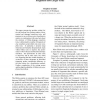Free Online Productivity Tools
i2Speak
i2Symbol
i2OCR
iTex2Img
iWeb2Print
iWeb2Shot
i2Type
iPdf2Split
iPdf2Merge
i2Bopomofo
i2Arabic
i2Style
i2Image
i2PDF
iLatex2Rtf
Sci2ools
ACL
2012
2012
Toward Automatically Assembling Hittite-Language Cuneiform Tablet Fragments into Larger Texts
This paper presents the problem within Hittite and Ancient Near Eastern studies of fragmented and damaged cuneiform texts, and proposes to use well-known text classification metrics, in combination with some facts about the structure of Hittite-language cuneiform texts, to help classify a number of fragments of clay cuneiform-script tablets into more complete texts. In particular, I propose using Sumerian and Akkadian ideogrammatic signs within Hittite texts to improve the performance of Naive Bayes and Maximum Entropy classifiers. The performance in some cases is improved, and in some cases very much not, suggesting that the variable frequency of occurrence of these ideograms in individual fragments makes considerable difference in the ideal choice for a classification method. Further, complexities of the writing system and the digital availability of Hittite texts complicate the problem.
| Added | 29 Sep 2012 |
| Updated | 29 Sep 2012 |
| Type | Journal |
| Year | 2012 |
| Where | ACL |
| Authors | Stephen Tyndall |
Comments (0)

